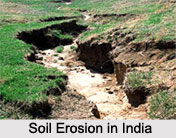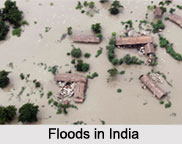 Soil Erosion in India is the natural process of removal of the topsoil or the upper layer of soil by various kinds of agents or forces. Soil erosion at different levels has occurred in different parts of India. There has been soil erosion in North and Central Zones, Eastern Zone and Western Zone of the country. Northern and Central Zones have almost identical patterns of soil eroding and bio-degrading forces. The highest level of erosion has been seen occurring in the Central Zone. Eastern Zone has prevalence of shifting cultivation and excessive rainfall. Western Zone has aridity. Southern Zone has aridity, low productivity and shallow soil depth. It is important to note that Southern Zone has the best preserved Indian forests. The forests in this zone are least affected by soil erosion, while the rest of the areas are almost equally affected. Thus, it can be comprehended why soil erosion is widespread in India.
Soil Erosion in India is the natural process of removal of the topsoil or the upper layer of soil by various kinds of agents or forces. Soil erosion at different levels has occurred in different parts of India. There has been soil erosion in North and Central Zones, Eastern Zone and Western Zone of the country. Northern and Central Zones have almost identical patterns of soil eroding and bio-degrading forces. The highest level of erosion has been seen occurring in the Central Zone. Eastern Zone has prevalence of shifting cultivation and excessive rainfall. Western Zone has aridity. Southern Zone has aridity, low productivity and shallow soil depth. It is important to note that Southern Zone has the best preserved Indian forests. The forests in this zone are least affected by soil erosion, while the rest of the areas are almost equally affected. Thus, it can be comprehended why soil erosion is widespread in India.
Causes of Soil Erosion in India
Soil Erosion in India can be attributed to several natural (like wind and water) and artificial factors (like deforestation and mining). In dry climate, wind blowing is the main cause of soil erosion. The most damaging of all the causes of soil erosion is rainfall. In India, almost 130 million hectares of land, that is, 45 percent of the total geographical surface area is affected by serious soil erosion by gorge and gully, shifting cultivation, cultivated wastelands, sandy areas, deserts and water logging. Soil erosion by rain and river that takes place in hilly areas causes severe landslides and floods. Hill-faces have been opened to extreme soil erosion by cutting of trees for making agricultural implements, firewood and timber, grazing of grasslands by a large number of animals as part of the livestock of India over and above their carrying capacity, construction of roads, traditional agricultural practices, indiscriminate quarrying, etc.  Agriculture and other land uses have also resulted in creating the major chunk of soil eroded areas.
Agriculture and other land uses have also resulted in creating the major chunk of soil eroded areas.
Types of Soil Erosion in India
The different types of soil erosion in India are normal or geologic erosion, accelerated soil erosion, wind erosion, water erosion, sheet erosion, gully erosion, landslides or slip erosion and stream-bank erosion.
Effects of Soil Erosion in India
Soil Erosion in India leads to Indian soils being deprived of its physical characteristics. It has resulted in huge loss of nutrients in suspension or solution, which are washed away from one place to another. It has ruthlessly affected agriculture in India and has damaged plants and crops. Besides the loss of nutrients from the topsoil, there has been degradation through the creation of gullies and ravines, which makes the land inappropriate for agricultural production. Subsidence of land in some areas and landslides in the hilly regions are the problems which have an effect on highways, habitations and irrigation dams. When the water droplets hit the soil, from there on, the flow of water causes sheet-wash, surface gullies, tunnels and scours banks in the rivers. Wind erosion causes development of deserts, dust, storms, whirlwinds and destruction of crops, while moving sand covers the land and makes it sterilized. Excessive soil erosion with resultant high rate of sedimentation in the reservoirs and decreased fertility has become solemn environmental problems for the country with disastrous consequences on the Indian economy.
Soil Conservation in India
Soil Conservation in India relates to the attempts made to restore the quality of soil in India. Soil erosion in India is amongst the leading areas of concern for the Government of India. Physical damage to soil is most likely to be remedied. Though soil erosion through natural agencies can hardly be checked, soil erosion through artificial means like mining, deforestation, etc is being strictly brought under the Indian Law System. Indian government is adopting adequate measures to reduce the negative effects of soil erosion in India.



















